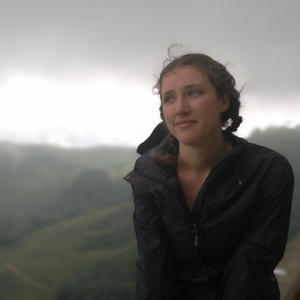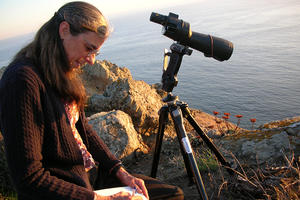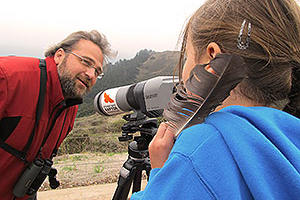
Scientist Profile: Lizzy Edson, Data Coordinator
San Francisco Bay Area Inventory & Monitoring Network, Golden Gate National Parks Conservancy and One Tam

Lizzy is the scientist behind the scenes. She helps other scientists extract meaning from the numbers they work so hard to collect. You’re most likely to find Lizzy behind her epic, 49-inch curved monitor, with spreadsheets filled with natural resources data and r scripts dancing across the screen. Her elegant handiwork underlies some of the San Francisco Bay Area parks’ most exciting Natural Resource projects: BioBlitzes, bat monitoring, the One Tam Health of the Mountain Project, and more. Lizzy was born in Cambridge, UK, where she worked in conservation and animal husbandry for many years before getting her undergrad degree in Environmental Management. She came to the United States—and the national parks—with a passion for uncovering stories of the natural world through data. Amidst her many projects with the parks, she is currently pursuing a M.S in Data Science from the University of Wisconsin.
“I was always interested in ecology from a young age because of my grandparents. We spent holidays running riot in Wales by the coast. We’d go rock pooling and fishing, and my gran would take my sister and I out on nature walks. She knew the plants and flowers, and we’d ask: ‘What’s this gran? What’s this?’ and she would answer. I started to see things in terms of ecosystems, rather than individual species.
“I knew I was interested in the natural world, so I left school to do conservation volunteering. My parents were really supportive when I didn’t want to go the traditional route of doing my A-levels and going straight to University. At the time, I didn’t feel the University course offerings were holistic enough—you could do pure science or geography, but not both—and it didn’t fit with how I felt conservation "worked". So I did a two-year practical degree in conservation and land management, then worked at a tiny country park as a ranger. I stayed there until the funding collapsed, then took an accidental break and worked with horses for many years. I knew at some point I wanted to go back into conservation, so I decided to go and get my undergrad degree.
“Because I’d been away for so long, I wanted to keep my degree quite broad. I found a program in Environmental Management that treated the environment as a holistic thing, which was always where my brain had put it, but wasn’t often seen in academia. With that program, I did a year doing GIS (Geographic Information System Mapping), and my inner nerd came out. I’ve always liked maps, and enjoyed seeing the patterns in the data when I started playing with it and looking at it spatially. I realized actually, I was quite nerdy. My husband had been telling me for many years, and finally I realized—yeah. Yeah I am.”
Finding her niche with the parks
“When I came here (to the U.S. and the Bay Area) I wanted to continue in that field. I started off volunteering with the Presidio Trust doing Presidio Plant Patrol, and someone mentioned a BioBlitz and internship coming up. And that’s how I started working here, as a ‘BioBlitz Science Intern.’ It was a science internship, but leaned towards the data management side.“The BioBlitz was fun because I got to see the whole data lifecycle. That really got me interested in how we spend vast amounts of resources and time collecting and maintaining natural resources data, and how data managers can help steward that data. In my work now, particularly with the San Francisco Bay Area Inventory and Monitoring Network, I help make sure data is high quality; that it doesn’t sit in a dusty drawer and that the containers people keep it in are useable, up to date, and secure. Data managers are the conduit for getting data from its raw stage to the finished product and out in the public world. I love bringing stories from the data to life. It’s allowed my inner nerd to grow.
“My role as the One Tam Data Coordinator was a totally new position that grew from a need, because One Tam was growing. They were doing the Marin Bat Monitoring and Wildlife Picture Index projects, and they needed someone to wrangle the data and make sure we weren’t just running out collecting data and not doing anything with it.

Mining the ‘big data’ in our natural resource data sets
“The One Tam Health of the Mountain project really opened my eyes to the ‘big data’ in our small data sets. When we hear the words big data, we tend to think of masses of Google click or Twitter data—all these giant, unstructured data sets—and trying to make sense of them. But for the Health of the Mountain report, the goal was to take all of our monitoring data and roll it up to say something about the state of Mt. Tamalpais. It got me super excited about the utility of data beyond saying something very specific about the thing you’re monitoring: being inferential and combining data in ways that it was not collected for, but actually makes sense when looking at it from a landscape scale. I’m very excited about helping people ask those questions, and then creating ways to communicate all that fun stuff to the public.
“That work really made me see that natural resources is ripe for thinking in more big data, holistic terms, and I wanted the skills to do big data mining. That put me on the path towards doing my masters in data science. Just thinking about getting our data out of these little siloed databases—not just for the National Park Service, but our partner agencies, too. We all collect similar data, so how can we say something bigger about the landscape? And how can we make that less of an effort, and more something that we do consistently?”
Life as a data scientist
“At the moment, it’s a lot of work and school. The ‘life’ is kind of squeezed in. But underneath, I so much enjoy what I do. I love learning and doing my masters (even though it gets stressful) and I love being here (in the parks), so it just feels like a happy place. Hard work, but a happy place. Once you start being a data manager, you find that people have such a need, and they don’t often have a person to help them. We need more data people!”
Advice for aspiring scientists?
“Just be super curious. Find the thing that excites you, and it might not be what you think it is! I never thought I’d work with data—I always thought I'd be a vet, I’d work outside, I’d be a biologist—and now here I am, doing this and absolutely loving it.”
Narrative adapted from an interview by Maritte O’Gallagher, February 2020.



